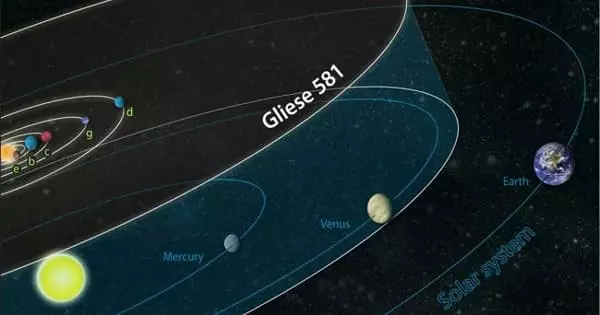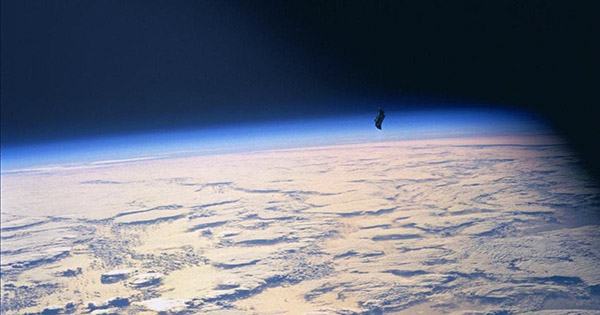Gliese 581d is an extrasolar planet orbiting within the Gliese 581 system in the Libra constellation, approximately 20.4 light-years away. This exoplanet, which is seven times the size of Earth, orbits Gliese 581, a star located 20 light-years away in the constellation Libra. It is the third planet claimed in the system and the fifth in order from the star (assuming a five-planet model).
The new research assumes that Gliese 581d, which is roughly seven times the mass of Earth, has a thick, carbon dioxide-based atmosphere. Though not confirmed to be a terrestrial planet and significantly more massive than Earth (at 6.98 Earth masses), the Super-Earth is the first exoplanet of terrestrial mass thought to be orbiting within its parent star’s habitable zone.
Computer climate simulations have confirmed the possibility of surface water’s existence, and these factors add up to a relatively high measure of planetary habitability. This planet was discovered with the help of a spectrometer, which measures the ‘wobble,’ or small changes in the wavelength of light emitted by a star caused by a planet’s orbit around it.
Discovery
In 2007, an astronomical team led by Stéphane Udry of the Geneva Observatory discovered the planet using the HARPS instrument on the European Southern Observatory’s 3.6-meter telescope in La Silla, Chile. The radial velocity technique was used by Udry’s team, which determines a planet’s mass based on the small perturbations in its parent star’s orbit caused by gravity. Gliese 581d was thought to be just outside its star’s habitable zone when it was discovered in 2007, but scientists later discovered that it is just close enough to potentially support liquid water.

Disputed existence
In September 2012, Roman Baluev filtered out the “red noise” in the Keck data and concluded that the existence of this planet is only probable to 2.2 standard deviations. That same year, however, S. S. Vogt (USNO), along with R. P. Butler and N. Haghighipour, confirmed the planet’s existence with a much higher probability; they also conducted a dynamical analysis of the system. Makarov and coauthors presented additional work on Gliese 581 as a four-planet system (thus including planet d), demonstrating its long-term orbital stability.
In 2016, E. R. Newton and colleagues noted that planets in the habitable zones of early M dwarfs may have orbital periods that coincide with the stellar rotation period (or, in rare cases, multiples of it, as in Gliese 581d); this aspect complicates the verification of any of those planets. As a result, this type of number relationship does not constitute a valid counterargument to the existence of such a planet, which tends to strengthen the case for the existence of Gliese 581d.
Based on 2007 studies, Gliese 581d will be the first planet identified to be located in a stellar habitable zone outside of the Solar System if the planet’s confirmation holds.
Orbital characteristics
Gliese 581d orbits Gliese 581 at 0.21847 AU, about one-fifth the distance the Earth orbits the Sun, though its orbital eccentricity has not been confirmed. There are currently two orbital models for it, one circular like Earth’s and one eccentric like Mercury’s. These are based on the Gliese 581 system’s four and six planet models, respectively. Gliese 581d would most likely be in a spin-orbit resonance of 2:1, rotating twice for each orbit of its parent star, according to the four-planet model. As a result, the day on Gliese 581d should be roughly 67 Earth days long.
The orbital distance places it at the outer limits of the habitable zone, which is the distance at which water is thought to be possible on the surface of a planetary body. The planet’s orbit was originally thought to be further out when it was discovered. However, in late April 2009, the original discovery team revised its original estimate of the planet’s orbital parameters, discovering that it orbits its star closer than previously thought, with an orbital period of 66.87 days.
Physical characteristics
According to the parent star’s motion, Gliese 581d has a minimum mass of 5.6 Earth masses (earlier analyses gave higher values). Dynamical simulations of the Gliese 581 system, assuming that the orbits of the three planets are coplanar, show that the system becomes unstable if the masses of the planets exceed 1.6–2 times the minimum values. Using earlier minimum mass values for Gliese 581d, this implies an upper mass limit for Gliese 581d of 13.8 Earth masses. However, the planet’s composition is unknown.
















